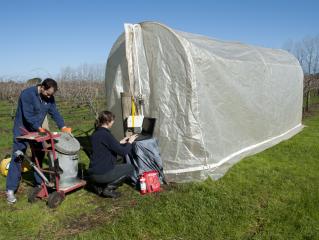Staff at the Department of Agriculture and Food, Western Australia have investigated the timing of when grapevines are sensitive and susceptible to smoke uptake.
To do so, apparatus was designed and tested to apply smoke to field-grown vines. This consisted of a steel-framed tent to surround vines to apply smoke from a smoke drum. Work was conducted on both DAFWA and commercial properties.
Research was conducted with Merlot vines over three seasons, during which they were exposed to smoke at key growth stages (10cm shoots, flowering, pea-size berries, beginning of bunch closure, veraison, grapes with intermediate sugar, berries not quite ripe, and harvest) to understand the level of smoke effect in the final wine.
Results showed the three key periods of vine sensitivity to smoke were:
- Shoots 10cm long to flowering: low sensitivity
- Pea-size berries through to three days post-veraison: variable (low to medium) sensitivity
- Seven days post-veraison to harvest: highly sensitive
Effect of smoke on fruit ripening
Smoke exposure can also result in delayed ripening of fruit. On some occasions, fruit from smoke-exposed vines has been shown to contain lower sugar content than fruit from unsmoked vines (Kennison et al. 2009). The delay in ripening is thought to be related to the effect of smoke on the functioning of the grapevine, with further studies investigating the photosynthetic response of grapevines to smoke exposure.
Varietal differences
The effects of smoke uptake in wine vary depending on the variety. Previous studies focused on Merlot only. These comprehensive studies were conducted over three years. Further studies have investigated the effect of smoke on other varieties including Cabernet Sauvignon, Chardonnay and Sauvignon Blanc. These found the timing of smoke uptake varies with variety. For example, some varieties may be more sensitive to smoke uptake earlier than others.
The difference may be due to a number of factors including seasonal weather conditions and vine health. Wine grape varieties can differ in plant structure and in aspects such as berry skin thickness, which may affect smoke uptake. Winemaking techniques can also influence smoke characteristics in the final wine. Generally, wine from white grape varieties has fewer smoke-related sensory and chemical effects due to the reduced contact time on skins compared with red wine production. All of these factors were considered in developing the Smoke Taint Risk (STAR) calculator.
Implications of smoke density and duration
Extensive field research was conducted to establish the quantity of smoke exposure needed to cause effect. This used field-based smoke detecting equipment (nephelometry) to measure the density and duration of smoke applied to grapevines.
The nephelometer measured smoke in units of obscuration per metre (%obs/m). This relates to the impairment of normal vision over a distance of 1 metre. Smoke was applied to vines at various densities (2.5, 5, 10, 20 and 30%obs/m) and durations (5 to 80 minutes) during growth periods defined as sensitive for smoke uptake.
The results showed a single heavy smoke exposure (30%obs/m) for 30 minutes at a sensitive stage of growth (from seven days after veraison to harvest) was sufficient to create smoke-related aromas, flavours and compounds in wine (Kennison et al. 2008). Lower smoke densities for shorter periods, also applied at a sensitive vine growth stage, can create differences detectable by consumers.
Smoke-like aromas and flavours are pronounced in wines produced from high smoke densities (20%obs/m) for short durations, and low smoke densities (2.5%obs/m) for long durations. It is important to note that grape harvesting, handling and winemaking techniques can influence smoke effect.
The effect of repeated smoke applications to the same vines was also investigated. Eight applications were made to the same Merlot vines throughout the growing season. Sensory and chemical analysis showed the smoke to have a cumulative effect on the levels of smoke-related compounds and aromas in resultant wines (Kennison et al. 2008). Therefore, repeated smoke exposure or exposure for a long period results in accumulation of smoke aromas and compounds in the final wine.
Potential carry-over of aromas and flavours
Grapevines were exposed to eight smoke applications from veraison to harvest (Kennison et al. 2011). Wine from this fruit contained distinct aromas of smoked meat, burnt rubber, leather and disinfectant/hospital. One year later, fruit from the same vines was harvested, made into wine and evaluated. Smoke-related aromas and flavours had not carried over to the next season. However, fruit yield from these vines was considerably lower (6.4kg) than vines that were not exposed (12.9kg). Repeated smoke exposure was therefore likely to affect grapevine functioning and its reproductive capability.
References
Kennison, KR, Gibberd, MR, Pollnitz, AP & Wilkinson, KL 2008, Smoke-derived taint in wine: the release of smoke-derived volatile phenols during fermentation of Merlot juice following grapevine exposure to smoke. Journal of Agricultural and Food Chemistry 56, 7379–83.
Kennison, KR 2009, Bushfire generated smoke taint in grapes and wine. Final report to Grape and Wine Research and Development Corporation, RD 05/02‑3.
Kennison KR, Wilkinson, KL, Pollnitz, AP, Williams, HG & Gibberd, MR 2011, Effect of smoke application to field-grown Merlot grapevines at key phenological growth stages on wine sensory and chemical properties. Australian Journal of Grape and Wine Research 17(2), S5‑S12.

